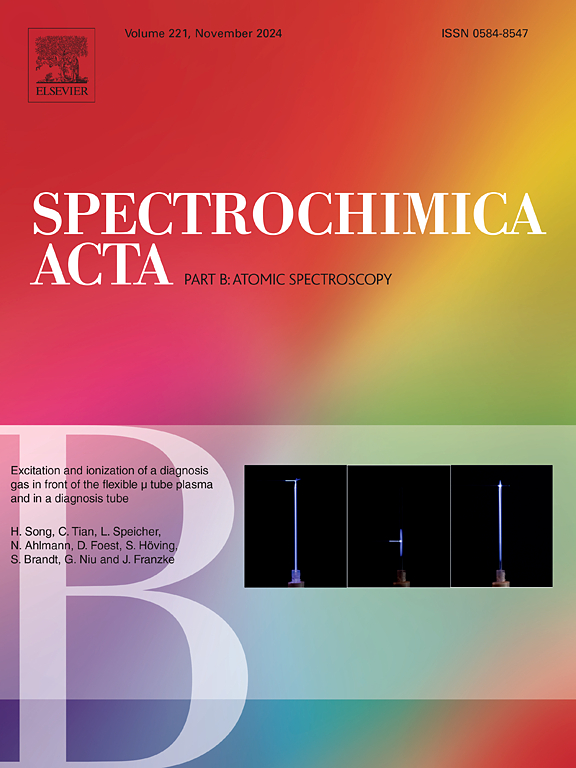氢化物雾化的辐射理论及其对痕量元素分析的意义
IF 3.2
2区 化学
Q1 SPECTROSCOPY
引用次数: 0
摘要
将挥发性氢化物的生成与相对简单的原子光谱分析方法--原子荧光光谱法 (AFS) 或原子吸收光谱法 (AAS) 相结合,可以实现极低的痕量元素分析检测限。为了使整个分析过程达到理想的性能,必须对与 AAS 或 AFS 耦合的专用雾化器(传统的外部加热石英管 - CQTA、微型扩散火焰 - MDF 和介质阻挡放电 - DBD)的设计和运行参数进行优化。在了解氢化物雾化器实际情况的基础上,这种优化可以通过一种简单明了的方式进行。要了解氢化物雾化器中的实际情况,必须考虑的关键一点是,雾化器的温度太低,无法对氢化物进行有效的热雾化。氢化物雾化的自由基理论解释了与多年观察到的氢化物完全转化为自由原子的经验之间的巨大差异。所提供的证据证实了 CQTA 中氢化物雾化的自由基理论。这使得在氢自由基分布定量的基础上优化这种雾化器的设计和运行参数成为可能,氢自由基分布可以通过双光子吸收激光诱导荧光实验或数值模拟来确定。关于将 CQTA 中的自由基理论推广到 MDF 和 DBD 雾化器的问题,需要更多关于自由分析物原子分布的实验证据来证实其正确性或发现其失败的原因。本文章由计算机程序翻译,如有差异,请以英文原文为准。

Radical theory of hydride atomization and its significance for trace element analysis
Extremely low limits of detection in trace element analysis can be achieved when coupling generation of volatile hydrides to the relatively simple methods of analytical atomic spectrometry - atomic fluorescence spectrometry (AFS) or atomic absorption spectrometry (AAS). To reach ideal performance of the whole analytical procedure, the atomizers dedicated for coupling with AAS or AFS (conventional externally heated quartz tubes - CQTA, miniature diffusion flames - MDF and dielectric barrier discharges - DBD) have to be optimized in terms of design as well as of operation parameters. Such an optimization can be made in a straightforward and elegant way based on the knowledge of what really happens in hydride atomizers. The key point which must be taken into account in order to understand what really happens in these atomizers is that their temperature is too low to be compatible with any significant thermal atomization of hydrides. The dramatic disagreement with the many years of experience of observing a complete conversion of hydrides to free atoms is explained by the radical theory of hydride atomization. The presented evidence corroborates the radical theory of hydride atomization in the CQTA. This makes possible optimization of design as well as of operational parameters of this kind of atomizer just on the basis of quantification of distributions of hydrogen radicals which can be determined either experimentally by two-photon absorption laser-induced fluorescence or potentially by numerical simulation. Regarding extension of the radical theory in the CQTA to MDF and DBD atomizers, more experimental evidence on free analyte atom distributions is required either to confirm its validity or to discover reasons for its failure.
求助全文
通过发布文献求助,成功后即可免费获取论文全文。
去求助
来源期刊
CiteScore
6.10
自引率
12.10%
发文量
173
审稿时长
81 days
期刊介绍:
Spectrochimica Acta Part B: Atomic Spectroscopy, is intended for the rapid publication of both original work and reviews in the following fields:
Atomic Emission (AES), Atomic Absorption (AAS) and Atomic Fluorescence (AFS) spectroscopy;
Mass Spectrometry (MS) for inorganic analysis covering Spark Source (SS-MS), Inductively Coupled Plasma (ICP-MS), Glow Discharge (GD-MS), and Secondary Ion Mass Spectrometry (SIMS).
Laser induced atomic spectroscopy for inorganic analysis, including non-linear optical laser spectroscopy, covering Laser Enhanced Ionization (LEI), Laser Induced Fluorescence (LIF), Resonance Ionization Spectroscopy (RIS) and Resonance Ionization Mass Spectrometry (RIMS); Laser Induced Breakdown Spectroscopy (LIBS); Cavity Ringdown Spectroscopy (CRDS), Laser Ablation Inductively Coupled Plasma Atomic Emission Spectroscopy (LA-ICP-AES) and Laser Ablation Inductively Coupled Plasma Mass Spectrometry (LA-ICP-MS).
X-ray spectrometry, X-ray Optics and Microanalysis, including X-ray fluorescence spectrometry (XRF) and related techniques, in particular Total-reflection X-ray Fluorescence Spectrometry (TXRF), and Synchrotron Radiation-excited Total reflection XRF (SR-TXRF).
Manuscripts dealing with (i) fundamentals, (ii) methodology development, (iii)instrumentation, and (iv) applications, can be submitted for publication.

 求助内容:
求助内容: 应助结果提醒方式:
应助结果提醒方式:


